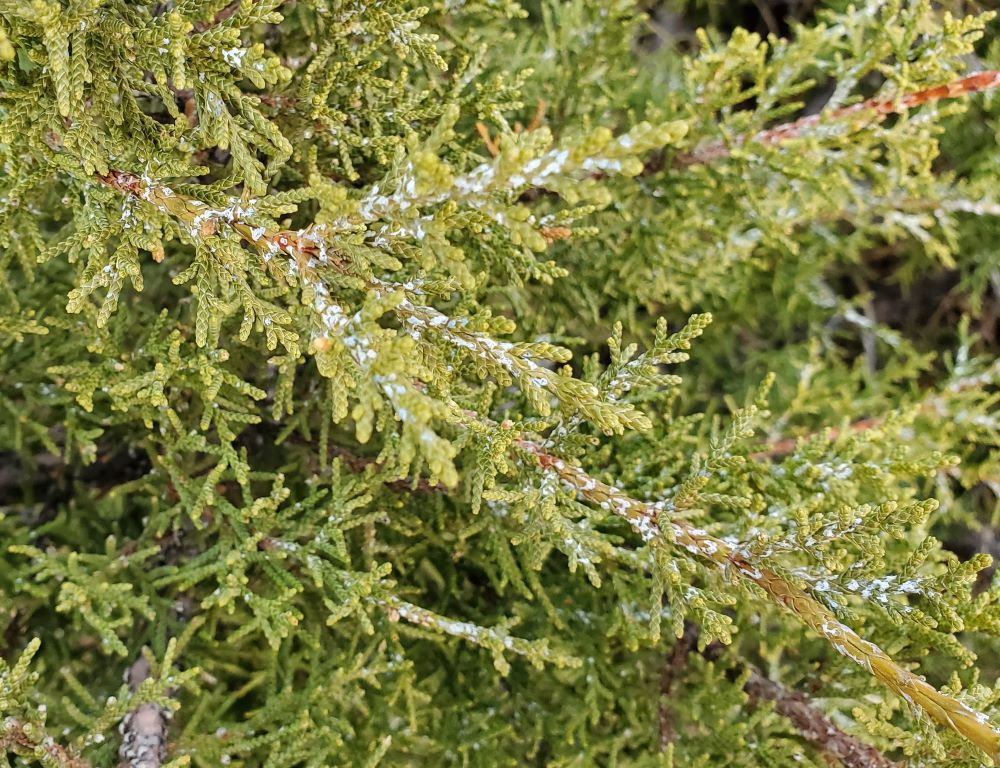January 29, 2024
By Linda Churchill, Director of Horticulture
As you wander through your garden (or ours) or enjoy woodland walks this month, you may notice a white substance on the foliage of our native one-seed junipers (Juniperus monosperma), especially on the branch tips with younger foliage. It’s particularly noticeable this time of year since in winter, with most other plants dormant, our evergreens capture more of our attention. Many of us are up close and personal with winter pruning, which also brings our eyes and attention much closer to our trees.

Photo by Toby Kessler
This white material is not a sign of plant disease or pests, but rather a natural product of the plant. If you examine young oneseed juniper twigs very closely with a good hand lens or a microscope, you may be able to see very small dark spots, actually glands, on the foliage. These glands produce a sticky resin which dries to a white crystalline form that you can see with your naked eye in the crevices between the leaf scales on the twigs. This resin is very aromatic, which you will notice as you prune the new foliage or even just stand near the tree on a warm day.

Photo by Linda Churchill
Resins are generally produced by woody plants. The liquid resins harden when exposed to air and they are not water soluble, hence the look of white crystals on the foliage. Resins likely help protect the plant from insects and pathogens and may reduce predation by herbivores.

Photo by Toby Kessler
The presence of this crystalline resin is one means to identify our native juniper species. Although many junipers do produce foliar resin, it is not present on two of the closest relatives of oneseed juniper, Rocky Mountain juniper (J. scopulorum) and Utah juniper (J. osteosperma). It is not always evident on all oneseed junipers, either. Soil or site conditions may affect whether and how much resin a tree produces. The plants where it is most obvious at Santa Fe Botanical Garden are junipers that have been the most heavily or frequently pruned, but are otherwise healthy.
Native Americans used juniper resin to treat colds and rheumatism, inhaling the smoke or using it in vapor baths to relieve symptoms.
You may simply admire this beautiful detail on your juniper foliage, inhale the refreshing fragrance, and be happy that a detail on your tree is, in this instance, a delightful characteristic of the tree and not something to worry about.
References
Heil, Kenneth et al. “Juniperus monosperma.” Flora of the Four Corners Region. Missouri Botanical Garden Press, 2013, p. 84.
“Resins.” U.S. Department of Agriculture: U.S. Forest Service. Web. 24 January 2024. Retreived from: https://www.fs.usda.gov/wildflowers/ethnobotany/resins.shtml#:~:text=Native%20Americans%20used%20resin%20from,including%20disease%2C%20since%20prehistoric%20times.
Schneider, Al. “Juniperus monosperma.” Southwest Colorado Wildflowers. Web. 25 January 2024. Retreived from: https://www.swcoloradowildflowers.com/Tree%20Enlarged%20Photo%20Pages/juniperus%20monosperma.htm

Photo by Linda Churchill


